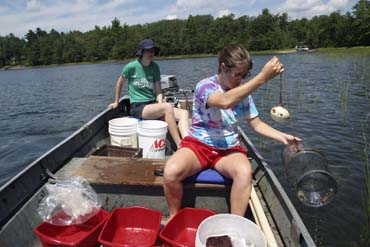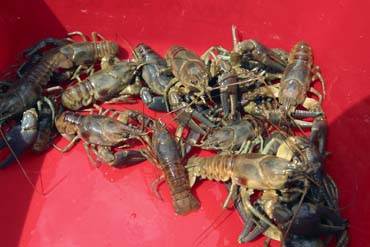Study shows hope for ridding lakes of clawed invader
The rusty crayfish — a voracious, bullying exotic that has visited ecological havoc on numerous Wisconsin lakes — may have finally met its match.

UW–Madison junior Ashley Gramza checks one of 200 crayfish traps set on Sparkling Lake in Vilas County, Wisconsin, while senior Nicole Hayes steadies the boat. An intensive program of trapping and manipulation of fishing regulations to increase the number of fish that prey on small crayfish may be the key to ridding Wisconsin lakes of the rusty crayfish, an invasive species that has set up shop in half of Wisconsin lakes and streams causing severe ecological degradation.

A group of rusty crayfish are displayed in a bucket after being trapped in Sparkling Lake. At the onset of the National Science Foundation-funded study five years ago, UW–Madison scientists and their students were extracting thousands of the invasive crustaceans from the 110-acre lake in Vilas County, Wisconsin. The population of the crayfish has been reduced significantly, suggesting it may be possible to devise similar strategies to rid other Wisconsin lakes of the crayfish that overpowers native species, destroys fish habitat and eats fish eggs.
Photos: Kurt Krueger
See also
Loving our lakes to death: Scientists study the human imprint on pristine lake country
Since its introduction to Wisconsin waters sometime in the 1950s, the crayfish has spread to thousands of lakes and streams, clear cutting the underwater forests that are critical fish habitat, evicting the native crayfish from one body of water after another and scooping up fish eggs like so much caviar.
But the clawed invader, the early results of a long-term University of Wisconsin–Madison study suggest, may be vulnerable to a “double whammy” of intensive trapping and predator fish manipulation to the point where it may actually be possible to rid lakes of an animal that has vexed scientists, anglers and conservation agencies alike for decades.
“They pretty much wipe out all of the rooted aquatic plants, they eat fish eggs, they either eat or compete with native invertebrates and, in general, raise havoc with the near-shore community of a lake,” says Stephen Carpenter, a UW–Madison professor of limnology and zoology involved in the study on Sparkling Lake in Vilas County, Wis.
Supported by the National Science Foundation (NSF), the long-term study of the feasibility of evicting the rusty from the 110-acre lake is now in its sixth year. It holds the promise of a rare victory in the war against introduced invasive species.
Since 2001, the UW–Madison researchers, aided by a small army of undergraduate students and the Wisconsin Department of Natural Resources (DNR), has succeeded in significantly reducing the population of rusty crayfish in Sparkling Lake through a program of intensive trapping and manipulating fishing regulations to favor the smallmouth and rock bass that dine on juvenile crayfish. The two-pronged attack, says Carpenter, has yielded very promising results.
“It seems to be working. The aquatic plants are back. That’s good because that’s fish habitat, and the fish populations are returning to what they were before the rusty got into the lake sometime in the 1980s,” says Carpenter.
The two-pronged approach to ridding Sparkling Lake of its rusty crayfish is the key, notes Jake Vander Zanden, a UW–Madison professor of limnology who is helping oversee the experiment. “One important message is that trapping alone will not do it. There’s a synergistic effect with the fish playing an important role.”
Smallmouth bass and rock bass, says Vander Zanden, are the primary predators of juvenile crayfish, and to some degree sunfish – bluegills and pumpkinseeds – pitch in by eating the smallest crayfish. The Wisconsin DNR, by manipulating the bag and size limits for anglers fishing Sparkling Lake, has helped establish an optimal population of the fish that routinely dine on the crayfish.
The trapping on Sparkling Lake, however, has been intensive during six years with 280 traps seeded around the lake. Baited with beef liver, the traps snare both native and rusty crayfish, but the natives, Carpenter explains, are returned to the lake. The trapping targets the largest crayfish, those that may be too big for the lake’s predators.
The big hope, says Carpenter, is that the experiment will expose a “tipping point,” where the combination of trapping and pressure from predator fish pushes the rusty crayfish population to crash, with the lake ecosystem returning to its pre-rusty crayfish state.
“What we are wondering is whether we will reach a tipping point where the fish alone can keep up the pressure,” says Carpenter, an authority on such ecological change. “We haven’t seen it yet, but we’re not prepared to admit there isn’t a tipping point.”
Vander Zanden says the rusty crayfish infestation in Sparkling Lake, like most lakes where it is found, was probably sparked by a small pioneer group that somehow got into the lake. At one time, rusty crayfish were used as bait. Misguided attempts years ago to establish the rusty in Wisconsin for commercial purposes also contributed to the spread of the exotic species to 50 percent of Wisconsin lakes and streams.
The practical upshot of the experiment and the real hope, say Vander Zanden and Carpenter, is that the experimental techniques used on Sparkling Lake can be transferred to other lakes with the help of the many lake associations in Wisconsin. The Wisconsin scientists have addressed lake associations and found a receptive audience.
“We have talked to lake associations,” says Carpenter. “If everyone was willing to run half a dozen traps off their dock, it could be very effective.”
And one of the best parts of the study, according to the Wisconsin scientists, is that the rusty crayfish is edible. “The students up at our Trout Lake Research Station have been eating a lot of crayfish,” says Carpenter.
Tags: biosciences, environment, limnology, research, water




